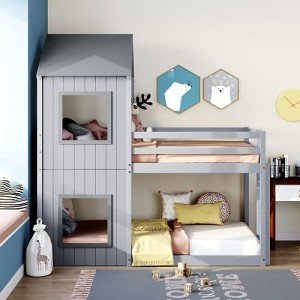12 Statistics About Bunk Bed To Bring You Up To Speed The Cooler Water Cooler
A Comprehensive Guide to Children's Bunk Beds: Styles, Benefits, and Safety Considerations
Bunk beds have actually become a popular option for households wanting to make the most of space and provide an enjoyable sleeping environment for children. With their special style, they use an innovative and useful option for shared bedrooms, playrooms, or even guest accommodation. This post checks out the different styles of children's bunk beds, their advantages, security considerations, and addresses some frequently asked concerns.
The Allure of Bunk Beds
Children's bunk beds are more than simply space-saving structures; they are also an entrance to adventurous dreams and creative play. Below is an in-depth examination of their numerous advantages.
Advantages of Bunk Beds
- Space-Saving: Bunk beds efficiently utilize vertical space, making them an ideal choice for smaller sized rooms.
- Playful Design: Many bunk bed styles include slides, tents, and themed aspects, triggering creativity and excitement.
- Partner Sharing: Bunk beds are best for brother or sisters sharing a space or accommodating sleepovers.
- Flexible Use: Some designs can be separated into two specific beds, providing versatility as kids grow.
- Storage Options: Many bunk beds come with integrated drawer storage or racks, further boosting their practicality.
Designs of Children's Bunk Beds
The variety of bunk beds offered today accommodates various choices and requirements. Below is an introduction of some popular designs.
Design
Description
Best For
Requirement Bunk Bed
A traditional style including one bed stacked above another.
Siblings sharing a room.
Loft Bed
Similar to a bunk bed without the bottom bunk, permits a work area or play area below.
Limited space for play/desk.
L-Shaped Bunk Bed
2 beds organized in an L-shape, often with extra areas for storage or play.
Special room layouts.
Twin Over Full
A twin bed over a complete bed, accommodating different sleep requirements.
Growing children and teens.
High Sleeper
Stands even higher than a loft bed, typically featuring a desk or play location below.
Older kids needing more play/desk space.
Camping Tent Bunk Bed
Bunk beds with a canopy or tent-like structure, developing a cozy, enjoyable space.
Active and imaginative children.
Key Features to Consider
When picking the ideal bunk bed for children, the following features deserve considering:
- Material: Bunk beds can be made from wood, metal, or a combination. click through the up coming website page has its distinct visual and sturdiness.
- Weight Capacity: Always verify the weight limit of the bunk bed to ensure it can accommodate your children securely.
- Security Rails: Ensure the leading bunk has strong rails to avoid falls.
- Ladder Security: A properly designed ladder must provide easy and safe access to the upper bunk.
- Ending up: Ensure any finishes are non-toxic and safe for children.
Safety Considerations
Security is vital when it comes to children's bunk beds. The following guidelines must be stuck to:
- Age Appropriateness: Generally, kids under 6 years old must not oversleep the upper bunk due to security threats.
- Strong Construction: Ensure the frame and products are solid and can support the weight without sagging.
- Regular Maintenance: Periodically look for loose screws, bolts, or other elements that may require tightening up.
- Clear Play Area: Keep the area around the bunk bed devoid of toys and challenges to reduce tripping hazards.
Setting Rules for Safe Use
Establishing standards for bunk bed usage will help make sure security:
- Limit Jumping and Climbing: Children must be advised versus leaping from the top bunk and climbing up on the sides.
- Supervising Sleepovers: Monitor young guests while they are utilizing the bunk bed for the very first time.
- Educate on Ladder Use: Teach how to utilize the ladder securely, stressing the significance of dealing with the ladder when going up or down.
Often Asked Questions
1. What age is appropriate for a kid to oversleep the top bunk?
Many producers recommend that kids need to be at least six years old to sleep in the upper bunk. This standard is created to alleviate the threat of falls.
2. Can bunk beds be tailored?
Yes, many makers offer personalized options, consisting of colors, products, and additional features like drawers or desks.
3. Are bunk beds safe for weight?
Bunk beds have weight limits, usually varying from 200 to 400 pounds, depending on the design and product. Constantly check the maker's specs.
4. How do I keep and clean up a bunk bed?
Regularly check for loose parts, keep the bed clean by cleaning down surface areas, and make sure the bed linen is fresh to promote a safe and hygienic sleep environment.
5. Can bunk beds be separated into specific beds?
Lots of bunk beds feature a choice to separate them into 2 private beds, providing long-term adaptability.
Children's bunk beds are more than mere furnishings; they are a practical, versatile, and creative component of a child's space. With different designs available and numerous safety factors to consider to remember, moms and dads can choose the best bed that fits their space, meets their kids's requirements, and imparts a sense of adventure. By comprehending the benefits, designs, and safety procedures related to bunk beds, households can create a delightful and safe and secure sleeping environment for their children. Whether for brother or sisters sharing a room or space-saving services, bunk beds stay a beloved choice for many families.
